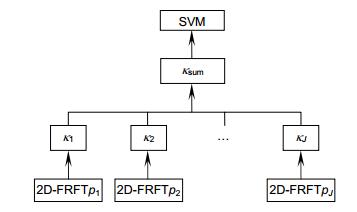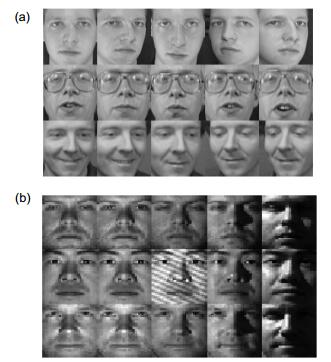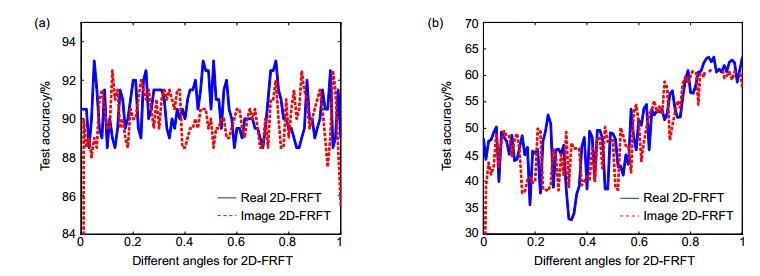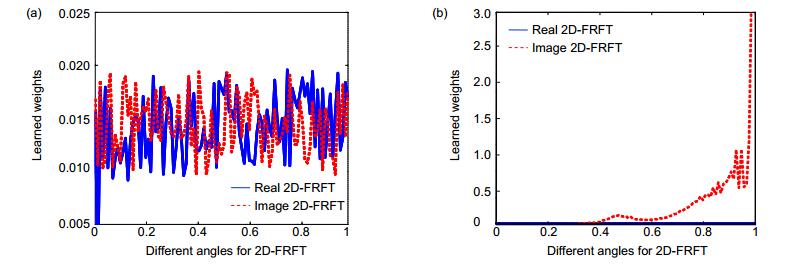Multiple order fractional Fourier transformation for face recognition based on multiple kernel learning
-
摘要:
分数阶傅里叶变换是信号处理与分析的一个重要工具,通过将图像信号投影到不同角度的时频平面可以表征图像的内容信息,其在人脸识别任务中显示出很好的性能。但是分数阶傅里叶变换存在阶次选择的问题,即在没有先验知识的情况下,无法预先知道哪一个阶次的分数阶傅里叶变换域特征具有最好的判别性能。受机器学习中的多核学习理论启发,本文探讨了分数阶傅里叶变换中阶次选择问题和多核学习理论的联系,通过将不同阶次的分数阶傅里叶变化域特征的线性核矩阵作为多核学习网络的输入,结合支持向量机,交替优化更新多核网络中的系数和支持向量机的参数,自动学习多阶次分数阶傅里叶变换域特征的系数,实现多阶次分数阶傅里叶变换域特征的融合。将所提算法应用到人脸识别任务中,在ORL人脸数据集和扩展YaleB人脸数据集上的实验显示所提算法的可行性和有效性。
 Abstract:
Abstract:Fractional Fourier transformation (FRFT) is a very useful tool for signal processing and analysis, which can well represent the content of the image by projecting it to the time-frequency plane. The features extracted by 2D-FRFT have shown very promising results for face recognition. However, there is one problem when dealing with 2D-FRFT: it is hard to know that which order of 2D-FRFT (the angle of projection of time-frequency plane) is best for the specific task without prior knowledge. In spirit of multiple kernel learning in machine learning, we discuss the relations between the order selection in 2D-FRFT and kernel selection in multiple kernel learning. By treating the linear kernels over different features from 2D-FRFT with different orders as the input to multiple kernel learning framework, and also by applying support vector machines (SVM) on top of the learned kernels, we can update the weights in the multiple kernel learning framework and SVM parameters through alternative optimization. Therefore, the problem of order selection of 2D-FRFT is solved by the off-the-shelf algorithm of multiple kernel learning. The experiments of face recognition on ORL dataset and extended YaleB dataset show the effectiveness of the proposed algorithm.
-

Overview: Fractional Fourier transformation (FRFT) is a very useful tool for signal processing and analysis, which can well represent the content of the image by projecting it to the time-frequency planes. The features extracted by 2D-FRFT have shown very promising results for face recognition. However, one problem is encountered when we apply 2D-FRFT tools for recognition problem: it is hard to know that which order of 2D-FRFT (the angle of projection of time-frequency plane) is suitable for the specific task without prior knowledge. The common method is that different orders are experimented and we empirically select the best one. In spirit of multiple kernel learning in machine learning, we discuss the relations between the order selection in 2D-FRFT and kernel selection in multiple kernel learning. Both problems can be considered as an equivalent problem when the features from 2D-FRFT in different orders with the subsequent SVM classifier can be transformed to linear kernels with SVM according to Representer Theorem. By treating the linear kernels over different features from 2D-FRFT with different orders as the input to multiple kernel learning framework, and also by applying support vector machines (SVM) on top of the learned kernels, the weights in the multiple kernel learning framework correspond to the order weights in the fusion of 2D-FRFT features of different orders, we can then update the weights in the multiple kernel learning framework and SVM parameters through alternative optimization. It is proceeding by first learning the parameters of SVM when fixing the parameters of multiple kernel learning, and then updating the parameters of multiple kernel learning by gradient descent algorithm when fixing the parameters of SVM. Learning iterations are stopped until convergence. Therefore, the problem of order selection of 2D-FRFT can be solved by the off-the-shelf algorithms of multiple kernel learning. We apply the proposed algorithm to face recognition task, and the experiments are conducted on the ORL dataset and the extended YaleB dataset. From the results it can be observed that: 1) The performance are improved by combining different 2D-FRFT features in different orders in compared to single order 2D-FRFT features; 2) The performance of different 2D-FRFT order fusion are comparable and even better than other classical features for face recognition, such as Eigenface, LBP and HOG; 3) The learned weights in the multiple kernel learning frameworks can give us clues about the contribution of each order of 2D-FRFT. In a nutshell, the experimental results show the effectiveness of the proposed algorithm.
-

-
图 1 不同阶次下的分数阶傅里叶变换域的特征。第一行为实数域特征,第二行为虚数域特征,从左到右阶次p分别0, 0.1, 0.2, 0.3, 0.4, 0.5, 0.6, 0.7, 0.8, 0.9, 1
Figure 1. Visualization of the 2D-FRFT features for one face. The first row is the features from the real coefficients of 2D-FRFT, and the second row is the imagine coefficients of 2D-FRFT. p value is 0, 0.1, 0.2, 0.3, 0.4, 0.5, 0.6, 0.7, 0.8, 0.9, 1 from left to right
表 1 最优单阶次分数阶傅里叶变换特征与多核学习的多阶次分数阶傅里叶变换域特征融合的识别率对比
Table 1. Performance comparison of best single 2D-FRFT features and multiple 2D-FRFT fusion based on multiple kernel learning
ORL数据集/% YaleB数据集/% 单阶次下最优实数域特征 93.0 63.42 单阶次下最优虚数域特征 92.5 62.87 本文方法 94.5 69.39 表 2 不同特征在两个数据集上识别率对比
Table 2. Performance comparison of different features and methods
不同方法 ORL数据集/% YaleB数据集/% Eigenface方法 95.0 64.76 HOG+线性核 96.5 56.67 HOG+RBF核 94.5 58.24 LBP+线性核 95.5 61.30 LBP+RBF核 95.0 60.44 本文方法 94.5 69.39 -
[1] Zafeiriou S, Zhang C, Zhang Z Y. A survey on face detection in the wild: past, present and future[J]. Computer Vision and Image Understanding, 2015, 138: 1-24. doi: 10.1016/j.cviu.2015.03.015
[2] 任福继, 李艳秋, 胡敏, 等.多特征描述及局部决策融合的人脸识别[J].光电工程, 2016, 43(9): 1-8. http://www.oee.ac.cn/CN/abstract/abstract1759.shtml
Ren F J, Li Y Q, Hu M, et al. Face recognition method based on multi features description and local fusion classification decision[J]. Opto-Electronic Engineering, 2016, 43(9): 1-8. http://www.oee.ac.cn/CN/abstract/abstract1759.shtml
[3] 龚飞, 金炜, 符冉迪, 等.融合小波包细节子图及稀疏表示的人脸识别[J].光电工程, 2016, 43(6): 32-38. http://www.cnki.com.cn/Article/CJFDTotal-GDGC201606007.htm
Gong F, Jin W, Fu R D, et al. Face recognition based on the fusion of wavelet packet sub-images and sparse representation[J]. Opto-Electronic Engineering, 2016, 43(6): 32-38. http://www.cnki.com.cn/Article/CJFDTotal-GDGC201606007.htm
[4] 冯海亮, 王应健, 罗甫林.基于稀疏相似保持算法的人脸识别[J].光电工程, 2016, 43(6): 19-24. http://www.wanfangdata.com.cn/details/detail.do?_type=perio&id=gdgc201606004
Feng H L, Wang Y J, Luo F L. Face recognition based on sparse similarity preserving algorithm[J]. Opto-Electronic Engineering, 2016, 43(6): 19-24. http://www.wanfangdata.com.cn/details/detail.do?_type=perio&id=gdgc201606004
[5] 余祥, 刘凯.基于相位测量轮廓术的人脸识别[J].光电工程, 2016, 43(6): 39-43. http://www.cqvip.com/QK/90982A/201606/669164763.html
Yu X, Liu K. Face recognition based on phase measuring profilometry[J]. Opto-Electronic Engineering, 2016, 43(6): 39-43. http://www.cqvip.com/QK/90982A/201606/669164763.html
[6] Cootes T F, Taylor C J, Cooper D H, et al. Active shape models-their training and application[J]. Computer Vision and Image Understanding, 1995, 61(1): 38-59. doi: 10.1006/cviu.1995.1004
[7] Cootes T F, Edwards G J, Taylor C J. Active appearance models[J]. IEEE Transactions on Pattern Analysis and Machine Intelligence, 2001, 23(6): 681-685. doi: 10.1109/34.927467
[8] Turk M A, Pentland A P. Face recognition using eigenfaces[C]// Proceedings of 1991 IEEE Computer Society Conference on Computer Vision and Pattern Recognition, 1991.
[9] Ahonen T, Hadid A, Pietikäinen M. Face description with local binary patterns: application to face recognition[J]. IEEE Transactions on Pattern Analysis and Machine Intelligence, 2006, 28(12): 2037-2041. doi: 10.1109/TPAMI.2006.244
[10] Dalal N, Triggs B. Histograms of oriented gradients for human detection[C]//Proceedings of the 2005 IEEE Computer Society Conference on Computer Vision and Pattern Recognition, 2005, 1: 886-893.
[11] Tirilly P, Claveau V, Gros P. Language modeling for bag-of-visual words image categorization[C]//Proceedings of the 2008 International Conference on Content-Based Image and Video Retrieval, 2008: 249-258.
[12] Belongie S, Malik J, Puzicha J. Shape matching and object recognition using shape contexts[J]. IEEE Transactions on Pattern Analysis & Machine Intelligence, 2002, 24(4): 509-522.
[13] Hinton G E, Osindero S, Teh Y W. A fast learning algorithm for deep belief nets[J]. Neural Computation, 2006, 18(7): 1527-1554. doi: 10.1162/neco.2006.18.7.1527
[14] Bengio Y. Learning deep architectures for AI[J]. Foundations and Trends in Machine Learning, 2009, 2(1): 1-127.
[15] Krizhevsky A, Sutskever I, Hinton G E. ImageNet classification with deep convolutional neural networks[C]//Neural Information Processing Systems Conference, 2012.
[16] Bruna J, Mallat S. Invariant scattering convolution networks[J]. IEEE Transactions on Pattern Analysis and Machine Intelligence, 2013, 35(8): 1872-1886. doi: 10.1109/TPAMI.2012.230
[17] 陶然, 邓兵, 王越.分数阶傅里叶变换及其应用[M].北京:清华大学出版社, 2009.
Tao R, Deng B, Wang Y. Fractional Fourier Transform and Its Applications[M]. Beijing: Tsinghua University Press, 2009.
[18] Burges C J C. A tutorial on support vector machines for pattern recognition[J]. Data Mining and Knowledge Discovery, 1998, 2(1): 121-167.
[19] 王亚星, 齐林, 郭新, 等.基于稀疏PCA的多阶次分数阶傅里叶变换域特征人脸识别[J].计算机应用研究, 2016, 33(4): 1253-1257. http://www.wanfangdata.com.cn/details/detail.do?_type=perio&id=jsjyyyj201604065
Wang Y X, Qi L, Guo X, et al. Fusion of complementary discrete fractional fourier features extracted through sparse PCA in generalized frequency domains for face recognition[J]. Application Research of Computers, 2016, 33(4): 1253-1257. http://www.wanfangdata.com.cn/details/detail.do?_type=perio&id=jsjyyyj201604065
[20] Sun H J, Chen E Q, Qi L. Face recognition based on the feature fusion in fractional fourier domain[C]//Proceedings of the 12th International Conference on Signal Processing, 2014: 1210-1214.
[21] Liu B W, Wang F. Face recognition approach based on 2D discrete fractional fourier transform[C]//Proceedings of the 3rd International Conference on Communication Software and Networks, 2011: 656-660.
[22] Lanckriet G, Cristianini N, Bartlett P, et al. Learning the kernel matrix with Semi-Definite programming[J]. Journal of Machine Learning Research, 2004, 5: 27-72.
[23] Bach F R, Lanckriet G R G, Jordan M I. Multiple kernel learning, conic duality, and the SMO algorithm[C]//Proceedings of the 21st International Conference on Machine Learning, 2004.
[24] Rakotomamonjy A, Bach F R, Canu S, et al. SimpleMKL[J]. Journal of Machine Learning Research, 2008, 9: 2491-2521. http://jmlr.csail.mit.edu/papers/volume9/rakotomamonjy08a/rakotomamonjy08a.pdf
[25] Sonnenburg S, Rätsch G, Schäfer C, et al. Large scale multiple kernel learning[J]. Journal of Machine Learning Research, 2006, 7: 1531-1565. https://sites.ualberta.ca/~szepesva/papers/mkl_icml2013.pdf
[26] Varma M, Babu B R. More generality in efficient multiple kernel learning[C]//Proceedings of the 26th Annual International Conference on Machine Learning, 2009: 1065-1072.
[27] Chang C C, Lin C J. LIBSVM: a library for support vector machines[J]. ACM Transactions on Intelligent Systems and Technology, 2011, 2(3): 27.
-


 E-mail Alert
E-mail Alert RSS
RSS

 下载:
下载:







